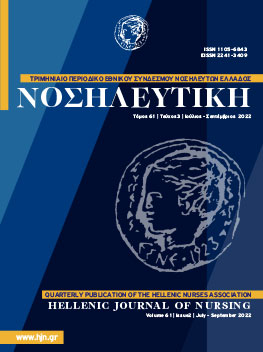Exploration of Factors related to Dyslipidaemia and High Anthropometrical Measurements in Young Adults
Background: During recent years significant changes have taken place in the dietary habits of the population in Greece, resulting in increased morbidity and mortality. The most common factors contributing to the deviation from the Mediterranean diet are urbanization, employment of both parents, improvement in the standards of living, promotion of a new life style and changes in the type of occupation. Aim: The aim of this study was to explore dyslipidaemia, body mass index (BMI) and waist to hip ratio (WHR) in young adults. Method: The study sample consisted of 300 students of nursing. Data collection was conducted by the use of a questionnaire specially designed for the needs of this study. The levels of cholesterol and triglycerides were measured in capillary blood, and BMI and WHR were recorded for each participant. Statistical analysis was performed using the Statistical Package for Social Sciences (SPSS) v15, employing the statistical methods x2 test, Anova test and t test. The statistical significance level was defined as p<0.05. Results: Of the 300 participants, 17.4% were men and 82.6% women. The statistical analysis showed that the men had relatively higher BMI and WHR (p≤0.001). Individuals aged > 25 years had higher levels of cholesterol (p=0.005) and triglycerides (p=0.035) and greater WHR (p≤0.001) than those aged < 25 years. Individuals living in student housing had higher levels of triglycerides than those who had not changed their place of residence (p=0.012), and those who lived alone (p=0.028) or with other persons (p=0.02). Individuals who had a student meals card had higher cholesterol levels than those without (p=0.017). Those who reported that their weight was above normal had higher levels of triglycerides (p=0037), and greater BMI (p<0.001) and WHR (p=0.020). Foreign students had higher levels of triglycerides (p=0.041) and lower BMI (p=0.049) than the Greek students. Greater WHR was observed in individuals with a family history of dislipidaemia (p=0.024) and those who consumed pastry foods more than twice a week (p=0.036). Individuals smoking more than 16 cigarettes per day had higher levels of triglycerides (p=0.007) than non smokers and those smoking less cigarettes. Conclusions: A family history of dyslipidaemia, the age and the type of nutrition were associated with high blood levels of cholesterol and triglycerides in young adults.
| Category: | Volume 50, N 1 |
| Hits: | 1024 Hits |
| Created Date: | 15-03-2011 |
| Authors: | Maria Polikandrioti , Eleni Evagelou , Anthi-Daphni Liveri , George Varelis , Sophia Giovaso , Eleni Kyritsi |
 English
English  Ελληνικά
Ελληνικά 

